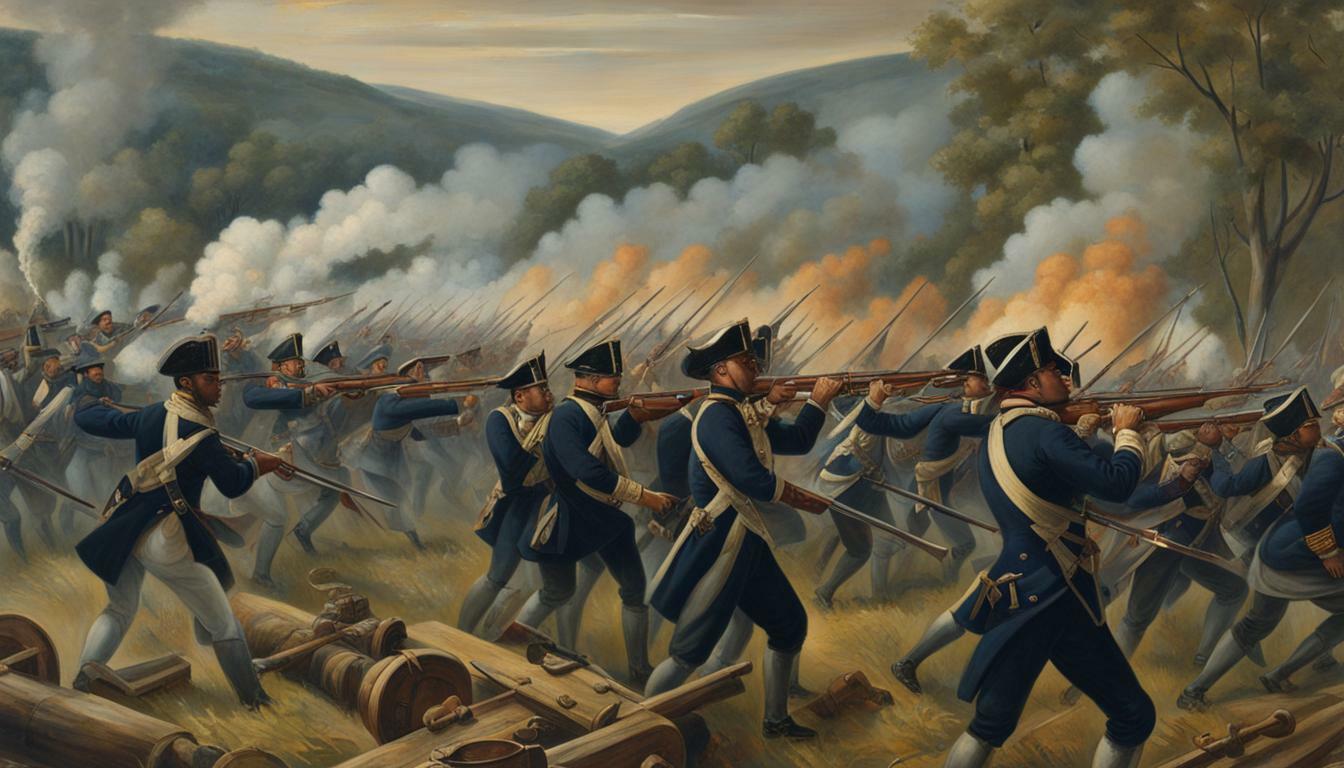The Battle of Harlem Heights was a pivotal event in the American Revolution, where the Continental Army, led by General George Washington, achieved a morale-boosting victory against the British Army in the heart of New York City. Taking place on September 16, 1776, during the New York and New Jersey campaign of the American Revolutionary War, this battle saw the Continental Army holding high ground positions in upper Manhattan, while the British army, under General William Howe, advanced towards them.
- The Battle of Harlem Heights was a significant turning point in the American Revolution.
- General George Washington led the Continental Army to a much-needed victory against the British forces.
- The battle took place on September 16, 1776, during the New York and New Jersey campaign.
- The Continental Army held high ground positions in upper Manhattan, providing a strategic advantage.
- Washington’s successful flanking maneuver and the arrival of reinforcements led to the British retreat.
The New York and New Jersey Campaign
The Battle of Harlem Heights was part of the broader New York and New Jersey campaign, a series of military engagements that occurred during the American Revolutionary War. Taking place on September 16, 1776, the battle was a pivotal moment in this campaign, with the Continental Army facing off against the British forces in upper Manhattan.
The campaign itself was a crucial chapter in the early stages of the war, as it aimed to control New York City and secure British dominance in the region. The British had already captured New York City in the previous weeks, leading General George Washington and his troops to retreat and regroup in northern Manhattan.
As the British forces, led by General William Howe, advanced towards the Continental Army, a skirmish broke out, quickly escalating into a running fight. The British pursuit proved to be their downfall, as they had ventured too far without proper reinforcements. This allowed Washington to make the strategic decision to execute a flanking maneuver in an attempt to cut off the British forces and regain the upper hand.
With troops arriving from the Harlem Heights position, the Continental Army applied pressure and forced the outnumbered British to retreat. Although the British attempted to make a stand with the help of reinforcements and field pieces, they were eventually compelled to pull back, resulting in an American victory and boosting the confidence of the Continental Army.
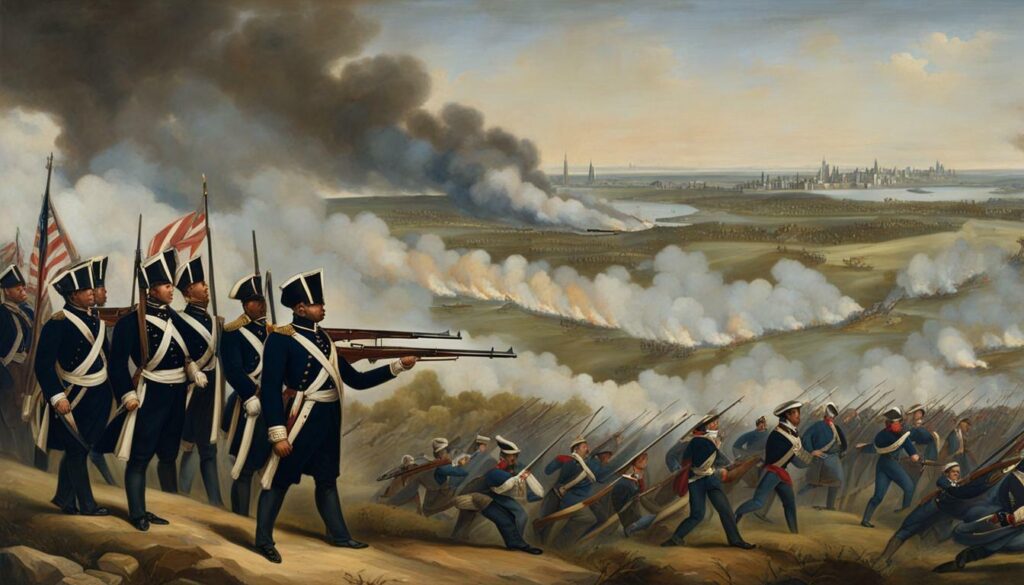
Pre-Battle Positions
Prior to the battle, the Continental Army, under the command of General George Washington, established high ground positions in upper Manhattan, while the British Army, led by General William Howe, made their advance towards them. The strategic advantage of holding the high ground was clear, as it provided the Continental Army with a better vantage point and made it more difficult for the British to mount an effective attack.
Washington recognized the importance of securing these positions, as they allowed for better control of the surrounding area and hindered the British advance. The Continental Army had taken advantage of the natural terrain features, positioning their troops on the heights overlooking Harlem Heights, a key area in upper Manhattan.
General Howe, leading the British forces, was determined to capture New York City and drive the Continental Army out of the area. However, the decision to attack the well-fortified American positions on the high ground proved to be a challenge for the British. The British Army faced a difficult task in trying to dislodge the Continental Army from their advantageous position.
Table: Positioning of Forces
| Continental Army | British Army |
|---|---|
| Under the command of General George Washington | Under the command of General William Howe |
| Established high ground positions in upper Manhattan | Advanced towards the Continental Army |
| Had a strategic advantage with better vantage points | Faced a challenge in attacking the well-fortified American positions |
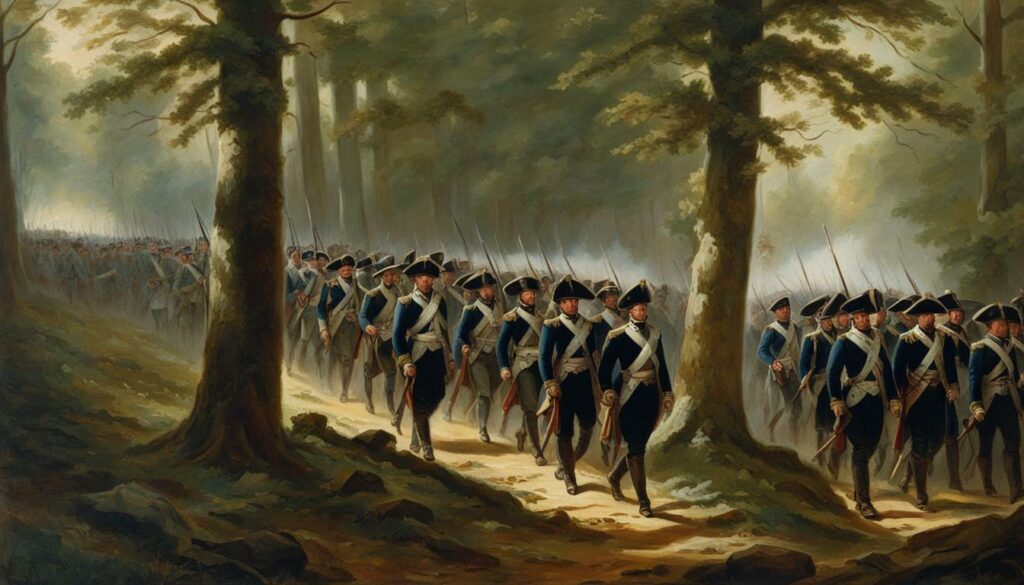
The positioning of the forces prior to the Battle of Harlem Heights set the stage for the ensuing conflict. The Continental Army’s high ground positions in upper Manhattan proved crucial in their defense against the advancing British forces. While the British Army attempted to overcome the strategic advantage held by the Americans, it would ultimately be their retreat that marked a turning point in the battle.
Skirmish and British Pursuit
The Battle of Harlem Heights began with a skirmish between American and British forces, which quickly transformed into a chaotic running fight as the British pursued the retreating Americans. The American forces, despite being outnumbered, put up a fierce resistance, utilizing their knowledge of the terrain to their advantage. The British, on the other hand, were caught off guard by the tenacity of the American soldiers, who launched surprise counter-attacks.
As the skirmish escalated, the British found themselves advancing too far without proper support, leaving their flanks exposed to the counter-attacks of the American troops. This strategic mistake allowed General George Washington to seize the opportunity and order a flanking maneuver to cut off the British forces. However, despite the American efforts, the flanking maneuver failed to completely encircle the British, who managed to break through the American lines.
With pressure mounting from troops arriving from the Harlem Heights position, the British were forced to retreat. They fell back, regrouping and seeking support. Meanwhile, American morale soared as news spread of their victory over the powerful British army. This triumph at the Battle of Harlem Heights was not only a turning point in the American Revolution but also a moment that restored the confidence of the Continental Army under the leadership of General George Washington.
| Key Points | Details |
|---|---|
| American Forces | Continental Army, led by General George Washington |
| British Forces | British Army, under the command of General William Howe |
| Skirmish | Started the battle between American and British forces |
| Running Fight | Chaotic battle as the British pursued the retreating Americans |
| American Victory | The British forces were forced to retreat due to pressure from the American troops |
“The British pursuit became a frantic race to catch up with the retreating Americans. The Battle of Harlem Heights was a pivotal moment in the American Revolution, demonstrating the resilience and determination of the Continental Army against a formidable foe. It marked the first battlefield success for General George Washington and helped restore the confidence of his troops. From this victory, Washington and his army would go on to secure future triumphs, shaping the course of the Revolutionary War.”
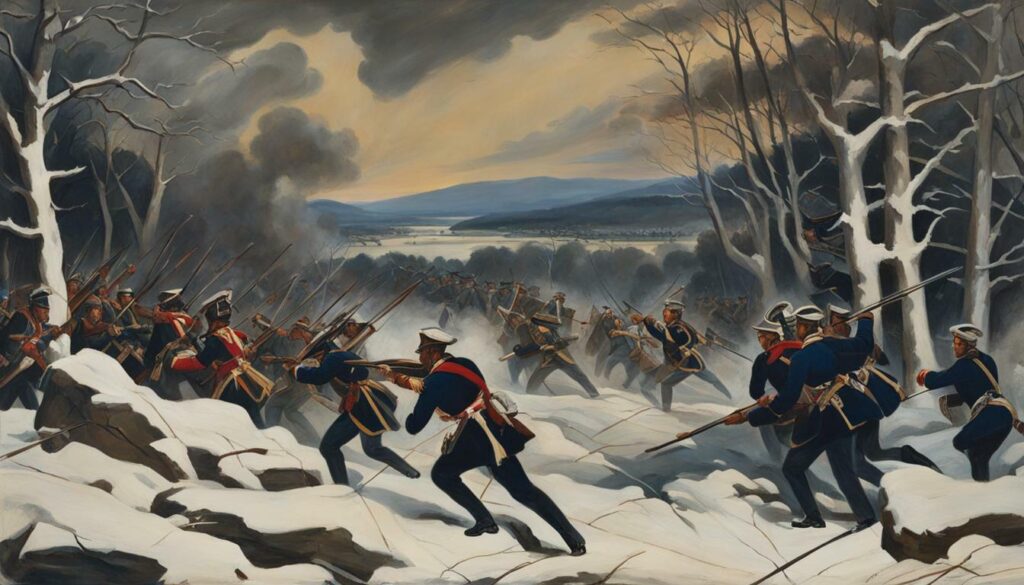
Sensing an opportunity, General Washington ordered a flanking maneuver to cut off the British forces, resulting in their retreat under the mounting pressure from troops arriving from the Harlem Heights position. The American forces, though outnumbered, displayed remarkable determination and skill in executing their strategic plan.
As the British army found themselves exposed and unsupported, they became vulnerable to counter-attacks from the Continental Army. The British soldiers had advanced too far without adequate reinforcements, leaving them in a precarious position.
Washington’s decision to execute the flanking maneuver proved to be a turning point in the battle. The American troops relentlessly pressed forward, gradually pushing back the British forces. This mounting pressure, combined with the arrival of reinforcements from the Harlem Heights position, proved too much for the outnumbered British soldiers to handle.
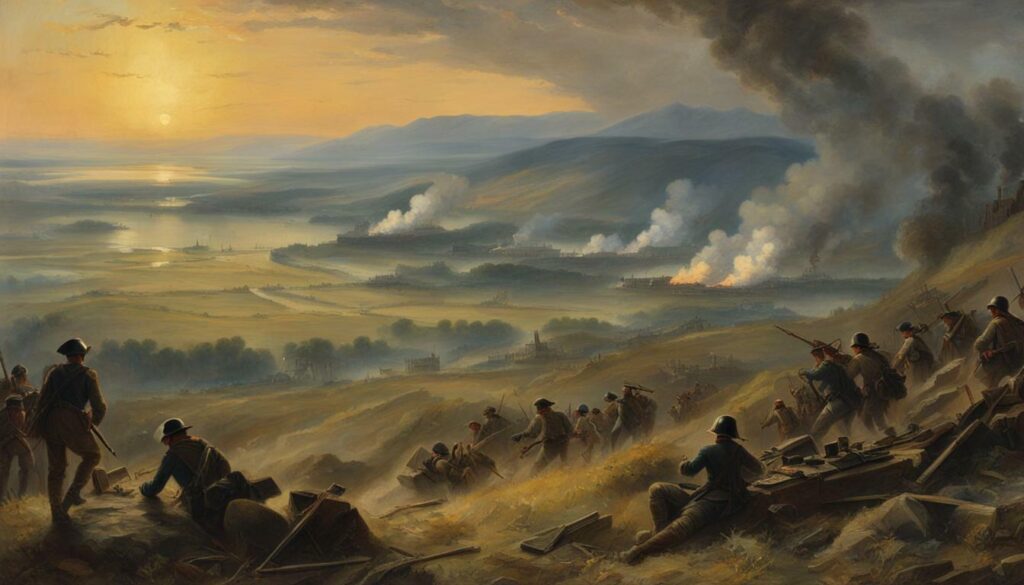
As the British retreated, they attempted to make a stand in open fields after receiving reinforcements and additional support from field pieces. However, their efforts proved futile, and they were eventually forced to pull back. The strategic brilliance of General Washington’s maneuver and the determination of the Continental Army led to a resounding victory for the American forces.
| Key Points |
|---|
| The American forces executed a flanking maneuver to cut off the British forces. |
| The British troops found themselves unsupported and exposed, leading to their retreat. |
| The mounting pressure from troops arriving from the Harlem Heights position contributed to the British retreat. |
| Despite being outnumbered, the Continental Army displayed determination and skill in executing their strategic plan. |
Stand and Forced Retreat
Despite receiving reinforcements and support from field pieces, the British light infantry made a stand in open fields but were eventually forced to retreat. The Battle of Harlem Heights, which took place on September 16, 1776, during the New York and New Jersey campaign of the American Revolutionary War, saw the Continental Army under the command of General George Washington clash with the British army led by General William Howe.
The British had advanced too far without adequate support, leaving themselves vulnerable to counter-attacks. Sensing an opportunity, Washington ordered a flanking maneuver to cut off the British force. However, despite the best efforts of the Continental Army, the British light infantry managed to maintain their position in the open fields.
As the battle unfolded, the British reinforcements arrived, including additional support from field pieces. This allowed the British to make a stand and temporarily hold their ground. However, the relentless pressure from the troops arriving from the Harlem Heights position proved to be too much for the outnumbered British forces. They were eventually forced to retreat, abandoning their position in the face of the advancing Continental Army.
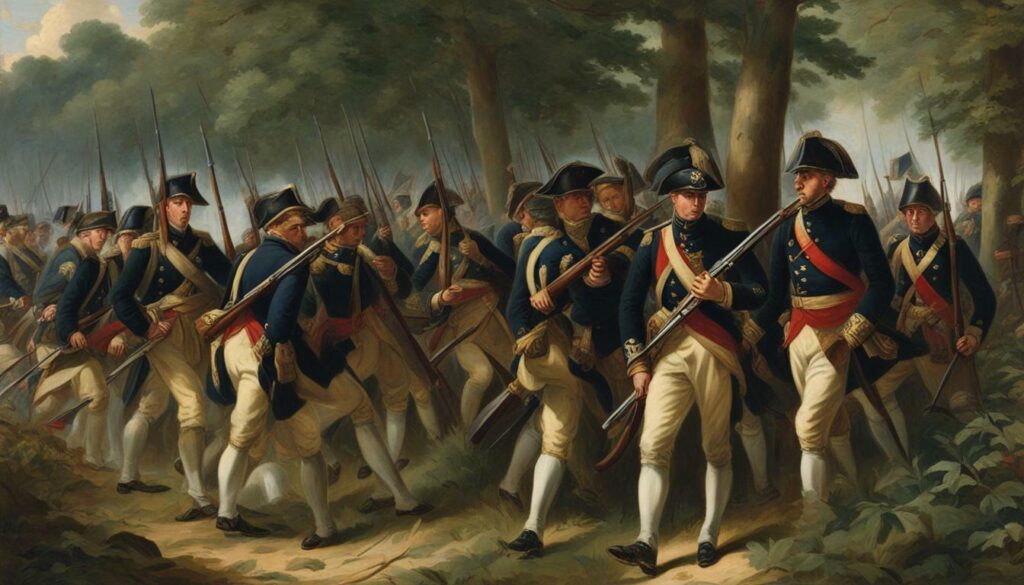
This image captures the moment when the British light infantry, despite their efforts to hold their position, were eventually forced to retreat from the open fields. It serves as a powerful visual representation of the pivotal moment in the Battle of Harlem Heights.
| British Reinforcements | Field Pieces | British Light Infantry | Forced Retreat |
|---|---|---|---|
| Despite the arrival of additional troops, the British forces were unable to fully turn the tide of the battle. | The added support from field pieces provided the British with a temporary advantage, but it was not enough to secure victory. | The British light infantry bravely held their ground in the face of mounting pressure from the Continental Army. | However, they were eventually overwhelmed and compelled to retreat, marking a significant turning point in the battle. |
Legacy and Historical Impact
The Stand and Forced Retreat of the British light infantry during the Battle of Harlem Heights holds great historical significance within the broader context of the American Revolution. The battle marked a morale-boosting victory for the Continental Army and a turning point in the war. It not only restored confidence in the American forces but also demonstrated the effectiveness of strategic military tactics employed by Washington.
The Battle of Harlem Heights has since become recognized as a pivotal event in military history, laying a foundation for future military strategies. The relentless determination and resilience displayed by the Continental Army during this battle set the stage for subsequent victories in the American Revolution, ultimately leading to American independence.
Through the Stand and Forced Retreat of the British light infantry, the Battle of Harlem Heights left an indelible legacy in American Revolutionary War history and solidified its place as a significant moment in the journey towards freedom.
American Victory and Restored Confidence
The Battle of Harlem Heights resulted in a resounding American victory, serving as a turning point in the American Revolutionary War and restoring much-needed confidence in the ranks of the Continental Army. Taking place on September 16, 1776, during the New York and New Jersey campaign, this pivotal battle showcased the strategic prowess of General George Washington and his troops.
After an early morning skirmish between American and British forces escalated into a running fight, it became evident that the British had advanced too far without sufficient support. Sensing an opportunity, Washington ordered a flanking maneuver to cut off the British force. Although the maneuver did not fully succeed, troops arriving from the Harlem Heights position increased the pressure on the outnumbered British, forcing them into a retreat.
The British attempted to make a stand in open fields after receiving reinforcements and additional support from field pieces, but the relentless offensive from the Continental Army proved too much. The British light infantry was eventually forced to pull back, ending the battle in a decisive American victory. This triumph not only boosted the morale of the Continental Army but also marked Washington’s first battlefield success in the war, instilling newfound confidence in his leadership.
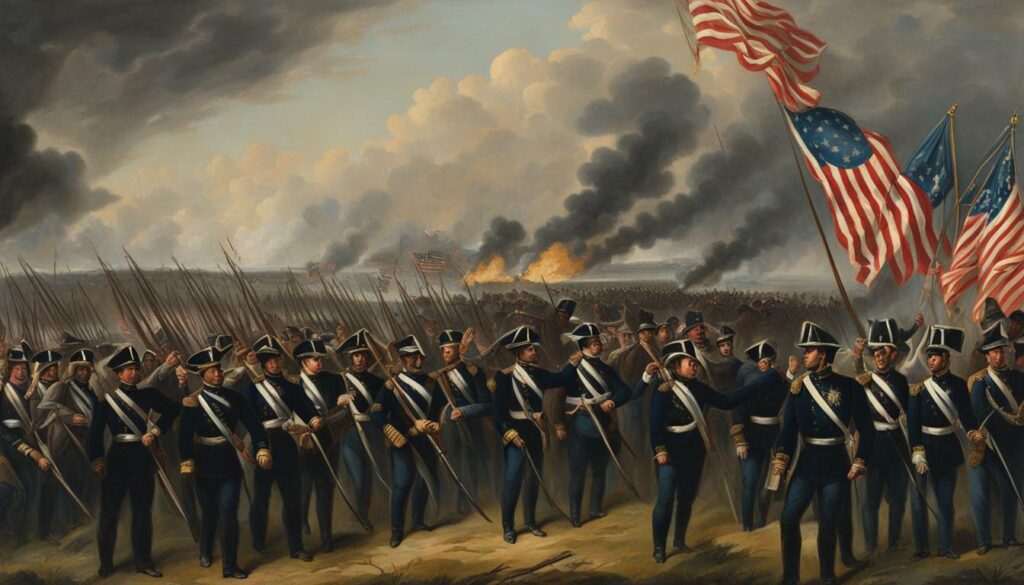
Legacy and Historical Impact
The Battle of Harlem Heights left a lasting legacy and had a significant historical impact. It showcased the resourcefulness and determination of the Continental Army, proving that they were a formidable force capable of standing up against the British army. This victory contributed to a shift in momentum during the American Revolutionary War and played a crucial role in increasing support for the American cause.
The Battle of Harlem Heights also highlighted the importance of military tactics and strategic war planning. Washington’s decision to execute a flanking maneuver, although not completely successful, demonstrated his tactical acumen and ability to exploit the British army’s vulnerabilities. This battle served as a valuable lesson in Revolutionary War warfare and influenced future military strategies.
In conclusion, the Battle of Harlem Heights was a momentous event in American Revolutionary War history. Its resounding American victory not only restored confidence in the Continental Army but also marked a significant turning point in the war. The legacy of this battle lives on, reminding us of the courage and tenacity of those who fought for American independence.
Significance in the American Revolution
The Battle of Harlem Heights holds immense significance within the American Revolution, standing as a testament to the determination and resilience of the Continental Army in their fight for independence. Taking place on September 16, 1776, during the New York and New Jersey campaign of the Revolutionary War, this pivotal event showcased the strategic insights and military tactics employed by General George Washington, marking his first battlefield success.
As the Continental Army faced the British forces in upper Manhattan, the high ground positions held by Washington’s troops provided a crucial advantage. The American soldiers, outnumbered but steadfast, engaged in a fierce skirmish that soon escalated into a running fight. The British pursuit, however, proved to be their downfall. Advancing too far without support, they found themselves vulnerable to counter-attacks.
Recognizing an opportunity, General Washington ordered a flanking maneuver to cut off the British forces. Although the maneuver itself was not successful, troops arriving from the Harlem Heights position exerted pressure on the British, forcing them into a retreat. The British attempted to make a stand in open fields after meeting reinforcements and utilizing field pieces, but they were ultimately forced to pull back.
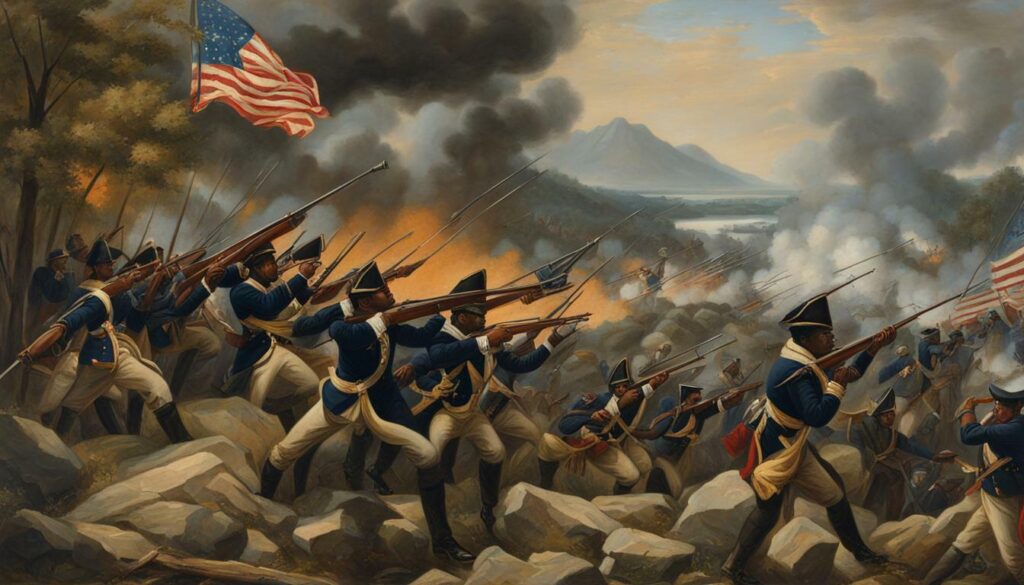
This American victory at the Battle of Harlem Heights played a crucial role in restoring the confidence of the Continental Army, which had faced numerous setbacks in the early stages of the Revolutionary War. It was a morale-boosting achievement that demonstrated the resilience and determination of the American forces, setting the stage for future successes in their fight for independence.
| Key Players | Significance |
|---|---|
| General George Washington | Leading the Continental Army, Washington’s strategic insights and decision-making during the battle showcased his military prowess. |
| General William Howe | Commanding the British forces, Howe’s pursuit and subsequent retreat highlighted the vulnerabilities of the British army during the campaign. |
The Battle of Harlem Heights displayed the determination of the Continental Army and marked a turning point in the American Revolution.” – Military Historian
The Battle of Harlem Heights remains an important event in military history, serving as a testament to the resilience and determination of the American forces. It marked a significant milestone in the American Revolution, boosting the morale of the Continental Army and setting the stage for future victories in their fight for independence.
Military Tactics and Strategic War Planning
The Battle of Harlem Heights showcased the military tactics and strategic war planning employed by both sides, offering valuable insights into the challenges and complexities of warfare during the American Revolution. General George Washington and his Continental Army relied on their knowledge of the terrain and the advantage of holding high ground positions in upper Manhattan to defend against the advancing British forces under General William Howe.
Washington understood the importance of maintaining a strong defensive position, utilizing the natural barriers and fortifying his troops accordingly. The Continental Army strategically positioned their troops and artillery to maximize their defensive capabilities, forcing the British to face a well-prepared and determined opposition.
On the other hand, General Howe’s British army employed aggressive tactics, utilizing their superior numbers and mobility to engage the Americans. However, their overextension and lack of proper support exposed them to counter-attacks and prevented them from achieving a decisive victory. The British light infantry’s attempt to make a stand in open fields showcased their determination, but ultimately they were forced to retreat due to the relentless pressure from the American forces.
The Battle of Harlem Heights serves as a significant example of the strategic challenges faced by both sides during the American Revolution. The Continental Army’s ability to strategically position their forces and effectively execute defensive maneuvers demonstrated their resilience and resourcefulness. Likewise, the British forces’ aggressive tactics and attempts to adapt to the changing battlefield conditions reflected the complexities of warfare during this period.
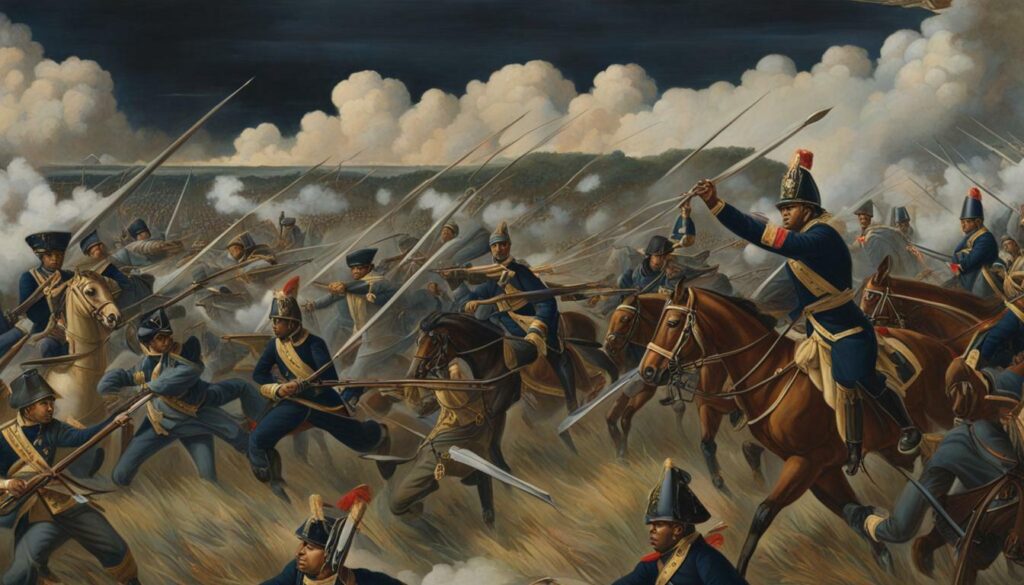
Strategic war planning played a crucial role in determining the outcome of the Battle of Harlem Heights. Both General Washington and General Howe employed different approaches to achieve victory. While Washington focused on defensive strategies and capitalizing on the terrain, Howe’s tactics emphasized aggressive maneuvers and seeking opportunities to engage the enemy.
Washington’s decision to execute a flanking maneuver demonstrated his understanding of the importance of cutting off the British forces and maximizing the advantage of their defensive positions. Despite the failed attempt, the pressure exerted on the British from troops arriving from the Harlem Heights position ultimately forced their retreat.
Howe’s decision to make a stand in open fields after receiving reinforcements showcased his confidence in British strength, but it proved futile in the face of the relentless American pressure. This highlights the challenges commanders faced, balancing offensive and defensive strategies while considering the rapidly changing dynamics of the battlefield.
| Key Strategies | Continental Army | British Army |
|---|---|---|
| Defensive Positioning | Utilized high ground positions to maximize defense | Focused on aggressive maneuvers and engaging the enemy |
| Flanking Maneuver | Strategically attempted to cut off British forces | N/A |
| Pressure and Counter-attacks | Relentless pressure and coordination forced British retreat | Overextension and lack of support exposed them to counter-attacks |
The Battle of Harlem Heights exemplified the strategic war planning employed by both sides during the American Revolution. From the effective defensive positioning of the Continental Army to the aggressive tactics of the British army, this pivotal battle provided valuable lessons in military tactics and shaped the course of the American Revolutionary War.
Legacy and Historical Impact
The Battle of Harlem Heights left a lasting legacy on both the American Revolution and military history, shaping future tactics and strategies in subsequent conflicts. This pivotal event in the Revolutionary War marked a turning point for the Continental Army and its commander, General George Washington.
Despite being outnumbered, Washington’s decision to hold high ground positions in upper Manhattan proved crucial in defeating the British forces led by General William Howe. The American victory at Harlem Heights boosted morale within the Continental Army and restored confidence in their ability to stand against the powerful British Army.
This success not only showcased Washington’s leadership skills but also highlighted the effectiveness of guerrilla warfare and defensive strategies employed by the American forces. The Battle of Harlem Heights demonstrated that a smaller, less experienced army could effectively use the terrain to their advantage and disrupt the plans of a superior force.
| Key Points | Historical Impact |
|---|---|
| Turning point in the American Revolution | The victory at Harlem Heights inspired hope and determination among the American colonists and encouraged their continued resistance against British rule. |
| Strategic use of high ground positions | The success of defending high ground positions influenced military tactics, with future commanders recognizing the importance of terrain in battle planning. |
| Guerrilla warfare techniques | The American forces’ effective use of guerrilla tactics served as a model for future conflicts, such as the American Civil War and Vietnam War. |
| Washington’s leadership skills | The victory at Harlem Heights solidified Washington’s reputation as a capable military commander and boosted his standing among his troops and fellow colonists. |
The Battle of Harlem Heights stands as a pivotal moment in American history, as it demonstrated the resilience and determination of the Continental Army in the face of adversity. Its impact on military strategies and tactics resonates even today, serving as a reminder of the importance of strategic planning and exploiting the advantages offered by the battlefield.
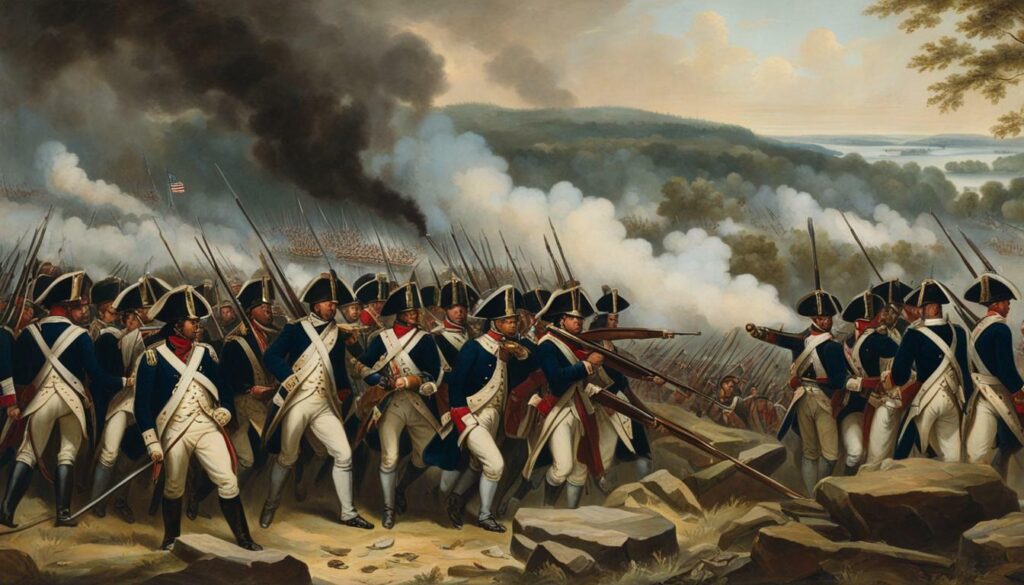
The Battle of Harlem Heights was a significant victory for the American forces, providing a much-needed boost to their morale and establishing General Washington as a capable leader. Its importance in shaping the tactics used in subsequent conflicts cannot be overstated.
- Key Points:
- Turning point in the American Revolution
- Strategic use of high ground positions
- Guerrilla warfare techniques
- Washington’s leadership skills
Through their triumph at Harlem Heights, the Continental Army proved that a determined and well-led force could stand up against the might of the British Empire. This battle served as a turning point in the American Revolution, instilling newfound confidence in the colonists and setting the stage for future victories.
Conclusion
The Battle of Harlem Heights was a decisive moment in the American Revolution, as the Continental Army achieved a crucial victory, providing a much-needed boost to morale and setting the stage for future successes in the fight for independence. Taking place on September 16, 1776, during the New York and New Jersey campaign of the American Revolutionary War, this battle showcased the strategic brilliance of General George Washington and the resilience of his troops.
From their high ground positions in upper Manhattan, the Continental Army faced off against the advancing British army, led by General William Howe. What started as an early morning skirmish soon escalated into a running fight as the British pursued the Americans. The British, having advanced too far without adequate support, found themselves exposed to counter-attacks from the Continental Army.
Recognizing the opportunity, Washington ordered a flanking maneuver, aiming to cut off the British force. Although the flanking maneuver did not achieve its intended objective, the pressure from troops arriving from the Harlem Heights position forced the outnumbered British to retreat. Despite meeting reinforcements and receiving support from field pieces, the British light infantry was eventually forced to pull back.
This resounding victory had a significant impact on the morale of the Continental Army. It marked George Washington’s first battlefield success of the war and restored confidence in the fledgling American forces. The Battle of Harlem Heights demonstrated the effectiveness of Washington’s strategic thinking and military tactics, setting the stage for future triumphs in the American Revolution.
FAQ
Q: When did the Battle of Harlem Heights take place?
A: The Battle of Harlem Heights took place on September 16, 1776.
Q: Who were the key players in the battle?
A: The Continental Army, led by General George Washington, and the British Army, led by General William Howe, were the main forces involved.
Q: What was the outcome of the battle?
A: The battle was an American victory, which helped restore the confidence of the Continental Army and marked Washington’s first battlefield success of the war.
Q: What was the significance of the Battle of Harlem Heights?
A: The battle was a pivotal event in the American Revolution, with lasting historical impact on military strategies and tactics employed during the war.
Q: Where did the battle take place?
A: The battle took place in upper Manhattan, New York City.
Q: How did the battle unfold?
A: An early morning skirmish between American and British forces developed into a running fight as the British pursued the Americans. The outnumbered British eventually retreated under pressure from American troops arriving from the Harlem Heights position.
Q: Did the battle involve any specific military tactics?
A: Both the American and British forces employed various military tactics and strategic war planning during the battle, showcasing the complexities of Revolutionary War warfare.
Q: How did the Battle of Harlem Heights impact the American Revolution?
A: The battle served as a morale-boosting victory for the Continental Army and marked a turning point in the war, restoring confidence and setting the stage for future successes.
Q: What was the larger military campaign in which the battle took place?
A: The battle was part of the New York and New Jersey campaign during the American Revolutionary War.
Q: What was the initial positioning of the American and British armies before the battle?
A: The Continental Army held high ground positions in upper Manhattan, while the British Army advanced towards them.
Q: Was the Battle of Harlem Heights a significant event in military history?
A: Yes, the battle holds historical significance in terms of its impact on the American Revolution and its influence on future military strategies.

